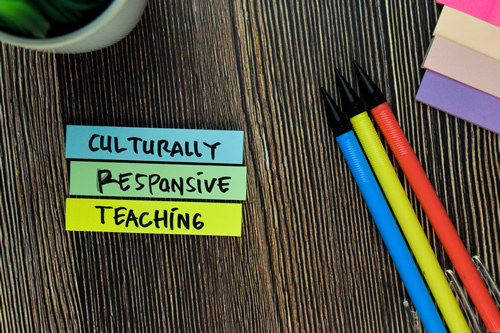The U.S. reached an important milestone several years ago—minority students now comprise the largest demographic group in our nation’s public schools. While there is great diversity within our student population, the majority of educators still do not share the same cultural experiences with the diverse students they serve.
However, many effective teachers have consistently been sensitive to and culturally aware of student backgrounds. These educators intuitively understand that the more inclusive their classroom is, the more engaged their students will be, and that engagement ultimately leads to achievement.
Culturally relevant teaching respects the traditional backgrounds of students as an asset in the classroom. In my own experience as a young child, I grew up in the U.S. with my parents having just arrived from Cuba, speaking no English. At the time, my teacher had very limited resources to help English learners, but she connected with me, and made a sincere effort to communicate with my parents and my family—and that made all the difference. My teacher made it clear through her words and actions that she was invested in me and my success. Just as my teacher did for me all those years ago, educators can all invest in the success of bilingual and multilingual students.
As educators, we are trained with the deficit model, which interprets that students who have limited English proficiency have an educational deficit that needs to be addressed. Transforming our classrooms necessitates that teachers investigate their own attitudes about different cultures—understanding any preconceptions they may have held and learning to value each student, including their background and the culture they bring to the classroom to share with their classmates.
Opportunities for bilingualism
In school year 2016-17, states reported almost 5 million emergent bilingual students across the U.S.—approximately 10 percent of the students in our public schools. It also may be surprising to learn that most U.S. students with limited English proficiency are actually U.S. citizens. Eighty-five percent of these were born in the United States, compared to 15 percent who were foreign-born. This truly sparks my curiosity: Why do English Learner (EL) programs typically assume all students are recently arrived immigrants when almost three-quarters of them were born in this country and speak some English?
The term “emergent bilingual” honors the native language, cultural background, and other assets students bring to the classroom, regardless of students’ place of birth. Educators should therefore be intentional about valuing the many gifts these students bring to the classroom and transition toward achieving educational equity for these students.
Students who speak more than one language have a clear advantage when preparing for participation in a global economy. A culturally responsive classroom, where all students can identify themselves and see their communities reflected in the content, is important. Although the personal connection between the student and teacher is critical, teachers can also support emergent bilingual students through embracing innovative instructional techniques, utilizing various resources, and intentionally fostering stronger connections to students’ families. Our world is beautifully diverse, and students will thrive in classrooms where all students are valued for the gifts they bring to the classroom. Teachers can intentionally create opportunities for students to share their cultural experiences and to connect to real-world issues.
6 steps to creating a culturally responsive classroom
Classrooms across the country are currently shifting to a technology-integrated blended learning model. Teachers are transitioning from a traditional instruction model to a coaching role that facilitates student engagement and critical thinking.
During the last few months of remote learning for students, teachers were learning a great deal about their students. Teachers now have a window into students’ home lives that they’ve never had before. This is an opportune time for teachers to incorporate students’ families, communities, and culture into their lessons.
Here are six steps to help you get started:
1. Tap into culture: Learn about your students! This is the key to culturally responsive teaching. Ask them questions about their lives and families. Talk with parents about the hopes and aspirations they hold for their children and encourage them to speak their first language together at home. Research the families’ cultures and visit their communities.
2. Design visual diversity: Students should be able to identify themselves in the displayed images, bulletin boards, classwork, and books that support their learning.
3. Create a student-centered classroom: Students that are truly engaged take ownership of their own learning. Engage students in culturally relevant learning by focusing on student engagement and collaboration.
4. Pronounce names correctly: Making the effort to pronounce your students’ names correctly builds trust and honors students’ cultural heritage.
5. Set high expectations: Use technology to meet the various needs of students. Every student should have access to scaffolding and learning accommodations until they are able to gain independence.
6. Embrace an asset-based mindset: Reflect on students’ individual strengths. Determine how you can use their interests, skills, and responsibilities from outside the classroom to guide instruction inside the classroom.
Schools that embrace culturally relevant and responsive instruction report higher levels of community engagement and academic achievement. This is good news! Let us continue to create culturally rich, diverse, and responsive classrooms that allow educators to establish the valuable foundations that will allow students to find and make their place in our changing world.
- High school students say AI will change the workforce - April 18, 2024
- Motivating students using the Self-Determination Theory - April 17, 2024
- Michigan Virtual’s statewide workgroup releasing AI guidance for K-12 educators - April 17, 2024


